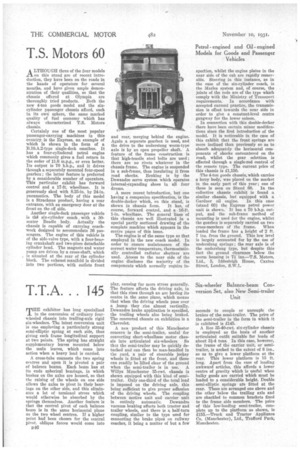T.T.A. 145
Page 36

If you've noticed an error in this article please click here to report it so we can fix it.
THE exhibitor has long specialized in the conversion of ordinary fourwheeled chassis into trailing-axle rigid six-wheelers. The latest conversion unit is one employing a particularly strong semi-elliptic spring at each side, thus giving each frame longitudinal support at two points. The spring has straight supplementary leaves mounted below the main leaves, which come into action when a heavy load is carried.
A cross-tube connects the two spring centres and upon it is pivoted a pair of balance beams. Each beam has at its ends spherical bearings, in which bushes on the axles are housed, so that the raising of the wheels on one side allows the axles to pivot in their bearings on the other side, and this eliminates a lot of torsional stress which -would otherwise be absorbed by the springs themselves. Another feature is that the central pivot of each balance beam is in the same horizontal plane as the two wheel centres. If a higher point had been chosen for the central pivot, oblique forces would come into
D46
play, causing far more stress generally. The feature affects the driving axle, in that this rises through an arc having its centre in the same plane, which means that when the driving wheels pass over a bump they rise almost vertically. Dewandre brake application is specified, the trailing wheels also being braked. The converted chassis on exhibition is a Chevrolet.
A new product of this Manchester concern is the semi-trailer, useful for converting short-wheelbase motor chas sis into articulated six-wheelers So that the semi-trailer may be quickly detached and can then be man-handled in the yard, a pair of steerable jockey wheels is fitted at the front, and these can readily be lifted clear of the ground when the semi-trailer is in use. A Willys Manchester 35-cwt. chassis is shown equipped with this kind of semitrailer. Only one-third of the total load is imposed on the driving axle, this being sufficient to give proper adhesion of the driving wheels. The coupling between motive unit and carrier unit is entirely automatic. Dewandre vacuum braking affects both tractor and trailer wheels, and there is a, half-turn coupling, similar to the type used for connecting the brake pipei; on railway coaches, it being a matter of but a few
seconds to couple or uncouple the brakes of the semi-trailer. The price of the semi-trailer in the form in which it is exhibited is 1145.
A Rea 35-40-cwt. six-cylinder chassis is employed as the basis of another articulated outfit suitable for loads of about 3-i-4 tons.. In this case, however, the frame of the carrier unit, or semitrailer, is arched to the extent of 8 ins., so as to giva a lower platform at the rear. This lower platform is 15 ft. long. Apart from the ease of loading awkward articles, this affords a lower centre of gravity which is useful when bulky goods are carried which must be loaded to a considerable height. Double semi-elliptic springs are fitted at the rear. These are arranged one above and the other below the trailing axle and are shackled to common brackets fixed to the frame side members. The price of this low-loading semi-trailer, complete up to the platform as shown, is £155.—Truck and Tractor Appliance Co. (Manchester), Ltd., Trafford Park, Manchester.
















































































































































